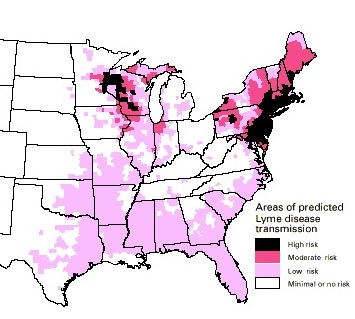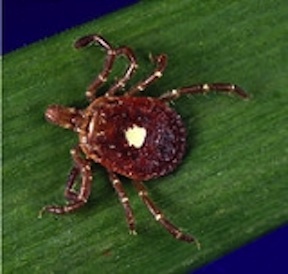It’s summer time and we’re playing outside. Guess who else is out and about? This nasty little bugger the deer tick. Ticks are known to transmit diseases, just like fleas and other insects which like to grab onto your pets. Deer ticks are the worst of all since they’re known to carry Lyme disease.
Lyme disease is an infectious disease caused by several bacteria of the genus Borrelia. It is the most common tick-borne disease in the world, transmitted from deer ticks throughout the Northern Hemisphere.
Good news: if you live below the Mason Dixon line there is a relatively low risk of Lyme Disease. Y’all can breathe easy. Folks who live in the forest regions of the Northeast have to worry. Check out this map from the CDC showing the riskiest places in the U.S. to contract Lyme Disease.

Southerners are at little to no risk of Lyme Disease. Yankees, y'all better watch out. (Image from the Center for Disease Control)
Do you live in a metropolitan area? Then your risk of getting Lyme Disease is slim to none. The culprits live mostly on deer, and y’all know deer don’t like cities.
If you do happen to find a tick, getting that sucker off within 36 hours greatly reduces the risk of Lyme Disease. Granted it’s hotter than Hades outside, but wearing protective clothing such as a hat, long-sleeved shirts and pants tucked into socks or boots prevents ticks from attaching to visible skin.
Do you have a dog or cat that likes to roam outside? The simple act of rubbing your pet down with a towel before letting them back in the house can shake any bugs off its fur. Also, be sure to keep your critter up to date with its flea and tick medication. Have a safe, disease-free summer!


I’m distressed to see this post. I know many people with Lyme disease and other tick-borne disease in the South. Florida, South Carolina, North Carolina, Virginia — these are all high-incidence areas. Not as high incidence as Massachusetts or Minnesota, but still definitely in the danger zone. For one thing, any coastal area is higher incidence. For another, ticks and Lyme are both moving increasingly into regions where they used to be scarce.
I even wrote a post about this myth of “We don’t have Lyme here.” As a result, one of my readers in a “low risk” area realized that her dog’s mysterious symptoms could be Lyme, got him tested (only the second time her vet had ever had a client request the test), and he was positive. Here’s the post: http://aftergadget.wordpress.com/2011/06/05/lyme-myths-not-a-problem-here/